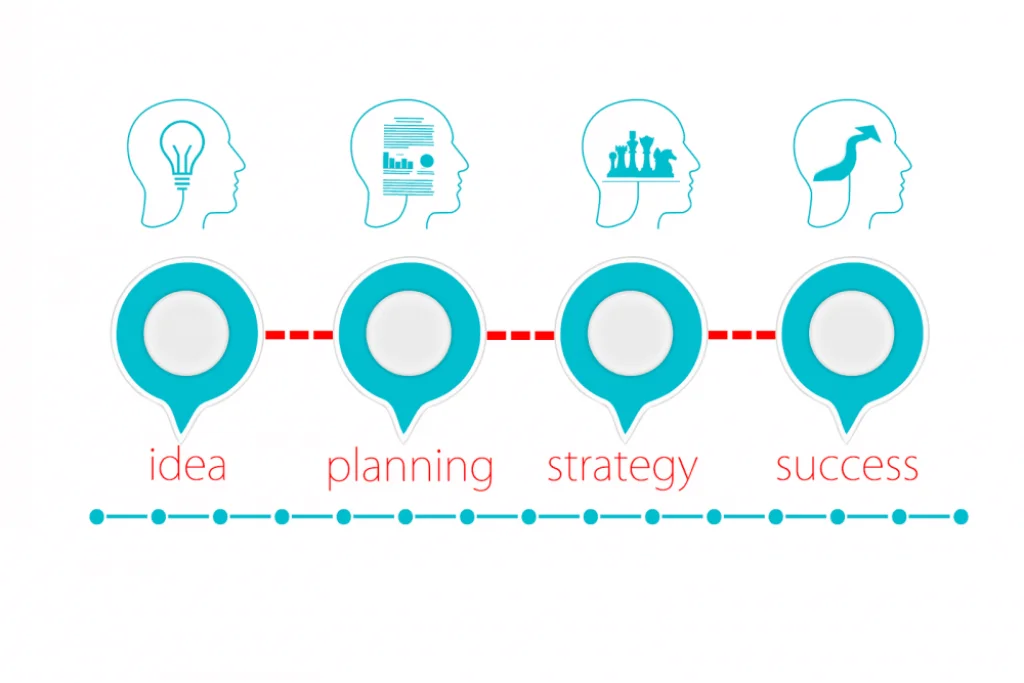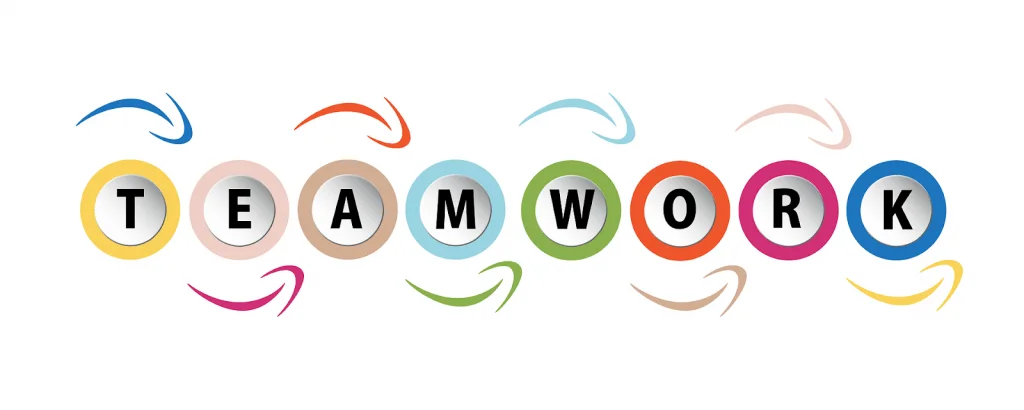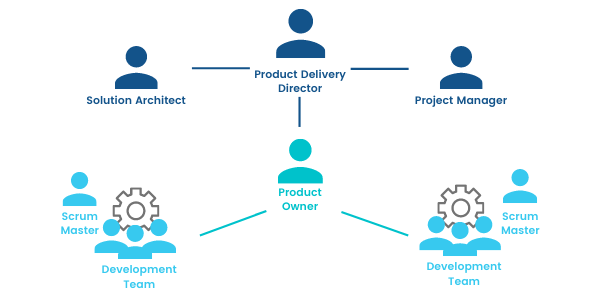Suppose you’ve never collaborated with such a software development team structure previously. In that case, you might assume that they’re just a collection of software engineers led by some form of a leader who works on main digital projects. Although there is some truth, the actual is far more complicated.
What Makes a Great Software Development Team?
The components of the software development team all seem to be experts engaged in the development phase. Designing, evaluating, analytics, programming, and a variety of other operations are some of the major functions performed by development team members during the development.
As each project has its own set of requirements, putting together a good team entails bringing together the necessary individuals to execute the project plan while maintaining a main objective perspective that emphasizes innovation, potential problem resolutions, creativity, and collaboration.

The Most Important Aspects of a Software Development Team’s Structure
1. Your Proposal’s Type and Sensitivity
You must first determine the extent of your task before jumping into the recruitment mania. If you’re building a prototype design, a crew of four people might be plenty to get the job done.
However, if you intend to build brand-new software with various features, including third-party partnerships, the size of your staff will almost surely grow. There are a few examples of how the entire project and the organization of a software development team could be related.
2. The Duration of Hours You Have to Finish the Task
The quantity and composition of your software development team structure will be influenced by how rapidly you ought to get your product about. Obviously, if there are fewer team members, it will take longer to get your desired target.
Thus, whether you have a vision for a cutting-edge product which requires to be built from the ground up on a short timeline, you may need to create a large group of senior engineers or maybe a group of engineers who really can address all needs and provide results swiftly and efficiently.
3. The Amount of Money Set Aside for Growth
The attainable budget, which is intricately linked to the criteria listed above, will have an impact on each and every selection you make, including how many members of the team one could recruit to the seniority of professionals you could engage in, how and why feature-rich the project becomes when it’s handed over.
“Do you know? You can create free websites for your small business using free website builders, but there are certain limitations. Let’s look at the 22 Best Free website builders and in-depth guide.
Read More: Top 22 Best Free Website Builders For Small Businesses”
Consider using some Agile project management techniques to cut project costs without losing quality during the development phase. You might provide in stages, focusing on the most important features, giving you more financial flexibility.
Three Approaches to Product Team Structure
Let’s start with the fundamentals.
One could organize an agile software development team structure in a variety of ways:
- Generalist
- Specialist
- Hybrid
1) Generalist
This team consists of individuals with a diverse range of talents and expertise. The generalists are tasked with developing an entire feature or task from start to finish. The team structure is used by the majority of outsourcing organizations.
Let’s consider the advantages and disadvantages.
Pros
Because everyone on the team understands how the system performs, it’s much easier to concentrate on product advancement.
Each member of the team can do the task at hand without the assistance of others.
Cons
Because no individual has particular knowledge, newer team members must be onboarded at all times while the task is underway.
2) Framework for Specialists
- Professionals with specialized skills and expertise dealing with specific duties and responsibilities make up a technical structure. Each team member is indeed an expert in one domain and is responsible for the obligations that come with it as they relate to the broader project. That’s how the majority of software development organizations work.
Pros
- Exceptional understanding of various project areas.
- Expertise in creating high-quality systems with minimal lag.
Cons
- Because each team member operates individually, it’s possible that the parts won’t fit together.
- A lack of general knowledge could also cause communication barriers.
3) Hybrid
The generalist and specialist structures are combined in a hybrid team setup. Whereas a hybrid team emphasizes the big picture, members can also get down to business when necessary. This hybrid construction combines the best features of both designs.
Pros
- The team comprises specialists who create specialized parts and generalists to ensure that everything works together.
- The developing procedure is efficient.
Cons
- Managing people with varied work styles can be difficult at times.
- To establish a hybrid team, you’ll need a lot of time and money.
Read Also: Design your “Customised Software” for better business growth.
What Role Does Each Component of a Software Development Team Structure Play?
Every person involved in IT development has a particular, critical role to play in achieving the best potential results. Projects will never be faultless, but with the proper team “on board,” they can come as near as practical to perfection, running smoothly according to strategy.
Above all, members of a competent software development team possess the necessary abilities and are not hesitant to assume responsibilities. Let’s have a look at the roles of individual professionals.

1) Business Analyst
- Understands the business processes of the consumer
- Relates client business objectives into specifications.
A. Define Goals and Objectives
A business analyst delves into a company’s operations and examines client inputs to help clients define their goals and connect their strategy to what a design team is generating. They take an abstract product concept and turn it into a collection of concrete needs.
B. Train Their Team
A BA brings to a products development team a deep grasp of business operations from numerous viewpoints and the ability to construct a software system that adds the most value to the company.
C. Bridge Between Client and Team
Until a software development team framework is determined, a business analyst can move in and bridge the level of the customer as well as the team throughout later phases.
2) Product Owner
- Is in charge of the product’s strategy and evolution.
- Ensures that the finished product satisfies the needs of the customer.
- Central Person of Development Team
A Product owner is a decision-maker who bears larger accountability for the development of a product than every individual on the development team. They establish a company strategy, shape their product vision, and ensure it fits consumer needs.
“A NoSQL JSON directory can store and recover information utilizing the “no SQL” rule. Read More: What are the advantages of NoSQL.”
- Handle a Product Backlog
They handle a product backlog while managing business necessities and market changes. A product owner, who is most often connected to agile environments, should indeed be able to operate well in situations whose specifications and procedures change constantly.
The duties of a BA and a PO appear to be very identical. What is the difference between the 2, and do both require use in the same project?
The main difference between a Product Owner and a Business Analyst is that a product owner gives the concept of a product while delving further into how it will be technically accomplished. In contrast, a business strategist bridges the barrier among a customer as well as a team despite being slightly extra technical.
As a result, a PO seems to be more customer-focused, whereas a BA is primarily project-focused. Experienced business analysts are typically capable of handling several of the responsibilities of a product owner, such as improving product inventory, modeling processes, and so forth.
3) Project Manager (PM)
- Assures that a product or a component is delivered on schedule and budget.
- Responsible for leading and motivating the software development team.
- Assigning Tasks to Team Members
A project manager in a sequencing model is in charge of assigning tasks to team members, coordinating work activities, and keeping track of project progress.
- Team Supervision
A PM puts up the concept of a product, ensures transparency, stimulates communication, seeks enhancements in the development approach, and ensures that a team produces more worth among each iteration in Agile projects. The priority is on self-management, visibility, and shared responsibility.
- Is the Project Manager Not Important for Agile Projects?
Some people assume that in an Agile setting with equivalent jobs like Service Delivery Manager or Scrum Master, there is no requirement for a PM, although this is not accurate. Possessing dedicated PMs is critical if your firm is operating many Agile projects at the same time. They’d bridge the dots on a group level between elevated stakeholder demands and day-to-day job execution, whereas a Scrum Master, for example, would oversee matters inside the team.
4) UX/UI Designer
- Creates user-friendly designs from a product vision.
- Provides user journeys that provide the best possible user satisfaction and performance levels.
- User interaction (UX) design, as well as customer interface (UI) designing, are two parts of the product development cycle.
UX Designers
The UX portion refers to planning out a user’s full journey when interacting with such a device. Research projects, personal building, informational design documentation, wireframing, modeling, and other activities are all part of what a UX designer does.
UI Designers
A UI designer, on the other hand, creates user interfaces that are straightforward, simple to use, and appealing to the eye.
A user interface/user experience (UI/UX) designer will work with you all through the development process, assisting you in achieving business objectives through effective and participating personal user experience, as well as assessing, evaluating, and improving those experiences.
Click Here: To Learn In Details About WordPress, its features, and its subscription Plan.
5) Architect for Software
- Creates software architecture at a high level.
- Chooses the right platforms and tools to bring the product idea to life.
- Establishes and maintains code with standards of quality, as well as conducts code reviews.
- An Expert-Level Software Engineer
Inside an app development group, an architect is indeed an expert-level software engineer that takes executive program design choices. If you’re working with such a software product with a lot of requirements or old software that needs a lot of adjustments, you’ll need one.
- GUIDE FOR BETTER RESULTS
An expert software development team structure determines which applications and databases must communicate with one another, how integration should function, and how the solution should be stable and secure.
6) Software Developer
- Designs the product and ensures its stability.
- Any technical issues that arise during the development lifecycle are resolved.
- Codes an Application
A software developer is the one who does the work and codes an app. Here are the front and spine developers, just as here are along with front head developers in an app.
- Front-end Developers
Front-end developers design the parts of a program that users engage with, verifying that the app provides a consistent experience across all devices, platforms, and operating systems.
- Back-end Developer
Back-end developers, on the other hand, create the app’s core – its algorithms and application logic. Back-end programmers that have worked in the field for a while can not only write software but also perform architect-like activities, such as devising an app architecture or designing and implementing the necessary connectors.
- Full-Stack Developers
There are also full-stack developers. They are capable of handling all aspects of the project at once, from customers to servers for databases and all necessary integrations.
7) Software Testing Engineer
- Performance of application should be done according to demands and needs.
- Highlight defects of functional and no-functional processes.
- Assure for Quality Out Comes
A software tester’s role is to make sure that a program meets all standards, either functional or non. Non-functional needs indicate how an app should do something, whereas applicable requirements describe what this would perform.
- Validate Functional and Non- Functional Standards
Test engineers do numerous tests to validate, analyze the tested findings and give feedback on the app’s performance.
- Evaluate an App From All Aspects
They evaluate an app from a variety of perspectives, including functionality, friendliness, security, and efficiency. QA experts may generate many types of testing information, ranging from test cases to test processes to test results summaries, to keep count of the conducted checks and guarantee that all criteria are fulfilled by tests.
“A content management system (CMS) enables you to create a website without writing any code. Read More: How To Choose CMS.”
8) Test Automation Engineer
- Responsibility for designing an ecosystem for test automation
- Creating and updating scripts for automated testing
- Assist In Rapid Testing
A test automation engineer is on hand to assist you with testing more quickly and effectively. To do so, they create test automation scripts, which are simple programs that give consistent and ongoing feedback on the performance of an app with no need for human intervention.
- Assist in Identifying Targets for Automation
A professional test automation engineer can assist you in determining which elements of an application are suitable targets for automation and should be tested using a manual method.
- Create Test Automation Ecosystem
They’d also create an incredibly simple or rather updated test automation ecosystem. Ultimately, they’ll ensure that the automation test project delivers the most value for the least amount of money.
9) DevOps Engineer
- Collaboration between development and operational teams is made easier.
- Builds continuous integration and delivery (CI/CD) networks for the speedy delivery
Development and services teams can be separated even in Agile contexts. DevOps engineers act as a bridge between both the two groups, integrating and automating the software product delivery and assisting in striking a balance between bringing modifications promptly while maintaining the stability of an app. DevOps engineers manage and facilitate source releases on a CI/CD basis, collaborating with computer software developers, sysadmins, and operating employees.
“Listed down 14 Tips to choose an expert and reliable web design company. Read More: How To Choose a Web Design Company”
Essential Guidelines for Maintaining the Effectiveness of a Software Development Team
1) Decide the size of the team.
The number of team members has an impact on most elements of the development lifecycle, based on your finances, business objectives, and timelines. The ideal Agile team size is from four to nine experts. If you must take a more traditional method, you can work with larger groups.
Smaller software groups seem to be more adaptable and capable of working alone. To minimize management issues, divide your team into smaller units if you really want to grow it and maintain its productive. You may organize your team under groups based on their phases of development, responsibilities, and expertise.
2) Clearly Define Roles and Responsibilities.
It’s a lot easier to stay busy and generate meaningful outcomes whenever the software team seems to have a unified goal, and each professional is mindful of their respective responsibilities. Define areas of commitment from the beginning to ensure that all tasks are done on time and within budget.
3) Create Your Workplace More Welcoming
It is critical to maintaining a favorable working atmosphere in order to keep professionals motivated and increase overall production. Ensure that all problems are dealt with and that everyone has the opportunity to stand up and discuss their thoughts with colleagues.
Minimize the power gap and empower professionals to take authority of the workplace if you’ve had a strong hierarchy organization.
4) Team Participants Could Communicate Effectively.
Without the need for a comfortable communication strategy, it’s impossible to create a top-notch service. Don’t forget to equip your staff with all of the resources they’ll need to communicate effectively.
Video conferencing technologies such as Zoom as well as Webex Meetings can assist your group stay on schedule and improving communication efficiency.
5) Don’t Micromanage Your Software Development Team.
Micromanagement irritates experts, undermines their confidence, and can lead to fatigue. You can begin by chatting with your technical talent to build trust and prioritize the things you must remain involved in.
Project management software can be a great method to supply your team individuals with the freedom they need while effectively delegating work. Task management, customizable reporting, and real-time collaboration are all made easier with tools like Trello, Airtable, and ClickUp.
Where Can You Find Ideal Teams of Experts for Your Project?
With “ENOU LABS,” you can find the ideal software team for any of your projects.
Our software development company delivers excellent outcomes to clients all around the globe. ENOU can assist you with a group of skilled specialists or a group of adaptable generalists. We have a large team of experienced engineers, QA professionals, designers, and project managers eager to help you grow your business!
“Software builders usually begin by sketching out what they would like the software to perform and how they plan to execute it. Read More: Software Building Process.”

What Is the Difference Between Traditional Team and Agile Team?
The main difference between the traditional and agile teams is that with huge and diverse teams and projects, the traditional technique works well. An agile team, on the other hand, usually comprises a small number of professional team members. The structure of the project management approach adopted has a significant impact on the severity of the finished result.
Traditional Team
- Project management from top to bottom.
- The project manager is in charge of completing tasks.
- Teams can work on multiple projects at the same time.
- Independent performance is assessed by an organization.
- Responsibilities and job titles that are unique.
- There are no restrictions on the number of people in a team.
- Human resources are the people who work for a company.
Agile Team
- The team that is conscience and supervised. The PM’s job is to manage the staff, remove roadblocks, and keep distractions at bay.
- Teams concentrate on a single project at a stage.
- The performance of a team is evaluated by an organization.
- Skills are more important than titles in cross-functional groups.
- Each squad should include three to nine people.
- Staff is considered talents in the industry.
What Distinguishes the Agile Software Development Team Hierarchy?
An Agile team, on the other hand, has additional job responsibilities; at the very least, take some pointers from the Agile Methodology.
- The importance of people through interactions outweighs the importance of processes and tools.
- Informative documentation takes a back seat to functional software.
- Detailed documentation is superseded by customer collaboration.
- Adapting to change takes precedence over adhering to a plan.
Collaboration, how people work together, differentiates an Agile team model from the traditional one.
An ultimate goal of SDLC 5 Phases is to make information systems or software development procedures greater in regularity, efficiency, and overall quality. Read More: SDLC 5 Phases and types of SDLC

Let’s look at a few of the responsibilities and functions of an Agile software development team.
The Product Owner (PO)
They are an important project stakeholder. This person has an in-depth understanding of the participants and the product and is in charge of the manufacturer’s internal operations. Their primary task is to ensure that the product meets the customer’s needs. They keep an eye on the team, offer assistance and coordination, and ensure the project is ready for market.
Scrum Master (Scrum Master)
It would be excellent if the term’scrum’ could be defined. Scrum is a methodology that focuses on Agile development concepts that allow an Agile team to organize itself and become more versatile. A scrum manager is the production manager who assists the work.
Team of Developers
These are in-house programmers who work as a team on the project. The Agile team includes front-plus back-end engineers, UX designers, and QA testers, more like organizational norms. They all work closely together on the product.
Why Is It So Important to Put Together the Right Team for a Project’s Success?
According to research, Collaborative decision-making habits produce better results. People who have the backing of a reliable and responsible team are more inclined to take appropriate risks that drive creativity. Working in a group fosters personal development, boosts work pleasure, and relieves anxiety. Let’s have a look at the importance of a good team.
- Manages to Balance Responsibilities
When a corporation hires a committed team that manages to balance responsibilities and duties, this is a regular occurrence. For example, going lacking the need of a product owner — the ultimate visionary in charge of developing a product that satisfies customer needs — frequently results in the release of software that fails to capture the hearts of its intended customers.
- Remarkable Outcomes
On a normal business level, inadequately thought employment decisions can also lead to missed opportunities. For example, a project manager might ignore the requirement for a DevOps engineer, denying oneself access to several rewards. During one of the programs, adding DevOps enabled our client to decrease. But release intervals from 10 to 2 weeks efficiently incorporate 30+ new functionality and attain an 80 percent code completion.
Our Recommendations for Hiring Development Team Structure
When it comes to picking developers with the right skill level, mistakes might happen. To save money, you may be hesitant to recruit senior engineers and instead hire less experienced personnel. We would recommend hiring your group with either an experienced professional developer or those having less expertise to determine the proper proportion of competence and fresh thoughts; the former will provide technical direction or indeed operate as a virtual CTO, whereas the latter would offer new ideas to the table.
“Do you know? A bug is usually a cause of mild (or considerable) discomfort. Bugs can sometimes be so serious that we have to quit using a piece of software entirely. Read More: How to reduce bugs in software.”
Final Thoughts:
The Ideal Group, although all of these jobs are necessary at some stage during software development, you may have certain projects that could do without one or two of them. You must have each of them on the team if possible because they each add uniqueness and capabilities to the development process. Although, as previously stated, it all relies on the type of construction you’re constructing, your circumstances, and your preexisting structure.
As you can see, forming a competent development team isn’t straightforward, as it necessitates paying attention to a variety of factors. If you’re having trouble with this or need to assemble an expert developer swiftly, consider seeking assistance from a seasoned source. Decades of IT development have equipped us with the expertise and methods necessary to make the best IT workers for any project, no matter how large or small.
FAQs
Why would you even be aware of the team and its function?
It is important because understanding what responsibilities are required for a successful development team puts you one step closer to building one.
What is the best structure for a software development team?
According to our software development expertise, a team of 3-7 individuals is the best size. You can also break a team into the sub-teams, every team with its team lead, when it’s a huge software development project.
What questions should I address with my development team?
Whenever recruiting a software development team, raise these five questions to the internal team.
1.Would this project fit into my overall business plan?
2.What is the development’s budget?
3.What are our plans for application management in the long run?
4.What deadlines do I have to meet?
5.Who Should Be Participating, and How Would They Take Part?



